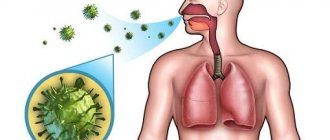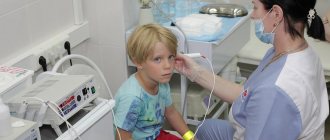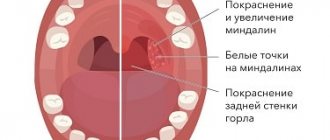What do pulmonologists treat?
As a rule, pulmonologists treat certain types of diseases:
- Chronic diseases in which sputum discharge is difficult;
- All types of bronchitis ;
- Pneumonia ;
- Inflammation of the alveoli and pleurisy in the lungs;
- Chronic obstructive respiratory diseases;
- Asthma;
- Pneumoconiosis and silicosis, as well as allergic diseases;
- Pneumothorax and emphysema;
- Abscesses and sarcoidosis.
But there are several types of diseases that a pulmonologist can only diagnose, but not treat. These include:
- Tuberculosis . He refers to a specialist - a phthisiatrician;
- Upper respiratory tract disease . For treatment, you must consult an otolaryngologist;
- Lungs' cancer. This disease is treated by a pulmonologist-oncologist.
Initially, you need to consult a general practitioner . And then the therapist gives a referral to a pulmonologist.
Scope of activity of a pulmonologist
A specialist in this narrow profile thoroughly knows the human respiratory system. He studies, diagnoses, treats and prevents diseases of the lower respiratory tract. Such pathologies include:
- pneumonia;
- bronchitis acute and chronic;
- diagnosis and treatment of bronchial asthma;
- bronchiolitis;
- tracheobronchitis;
- pleurisy;
- pulmonary embolism;
- hamartoma - a benign tumor on the lung;
- pulmonary idiopathic hemosiderosis;
- hemothorax;
- pneumothorax;
- idiopathic fibrosing alveolitis;
- pulmonary infarction;
- pulmonary-alveolar proteinosis;
- pulmonary fibrosis;
- sarcoidosis;
- night apnea - this disease should be under the supervision of another person, since the patient does not feel what is happening to him at night, breathing stops for up to 3 minutes;
- pulmonary emphysema.
Bad habits of adults significantly complicate any treatment of diseases, but especially the treatment of the respiratory tract.
Therefore, in case of such pathologies and the presence of bad habits, it is better to contact a specialist, because a pulmonologist treats, selecting a therapeutic complex individually. Subspecialists in the lower respiratory tract know the dangers of frequent smoking. Their actions are aimed at preventing asthma attacks in long-time smokers. With extensive smoking experience, harmful substances irritate the bronchi and lungs, which leads to attacks of uncontrollable coughing, suffocation and a catastrophic lack of oxygen.
A bronchial and lung specialist also prescribes treatment for occupational diseases:
- Silicosis. The disease is common among workers in the mining industry, metallurgy in foundries, and those working in the production of ceramics and refractory materials. With constant inhalation of silica, connective tissue in the lungs grows, which leads to other diseases of the respiratory system.
- Psittacosis. Often found among poultry farm workers, farmers and other professions related to poultry breeding. Caused by chlamydia, transmitted through airborne dust. Affects the lungs, central nervous system, leads to enlargement of the liver and spleen.
- Silicatosis. People inhale silicate dust at various industrial sites.
- Asbestosis. Develops from constant work with asbestos and inhalation of its dust.
- Talkoz. Appears due to prolonged work with talc dust.
- Anthracosis. Occurs after prolonged inhalation of coal waste and dust.
- Siderosis. The disease appears in workers with iron dust and other diseases due to chemically hazardous professional activities.
Pulmonologist's arsenal
Every pulmonologist has a wide arsenal of diagnostic methods that can be used to analyze biological fluids. And also determine the presence of bacteria.
- X-ray is a radiation method that results in a “photograph” of the lungs.
- Bronchoscopy - allows you to examine the bronchi from the inside in detail. And also with its help, you can take the necessary material for research and administer medications.
- Tomography . To look for abscess formation, cysts, necrosis and tumors.
Biomaterial research:
- Blood analysis . Determines the presence of inflammation, allergic reactions, hemoglobin, and so on;
- culture of sputum . Helps to identify the causative agents of the disease in order to prescribe an effective drug;
- Allergy tests . They identify allergens that cause respiratory problems.
When should I contact a pulmonologist with children?
Parents should be attentive to the condition of their children in order to prevent the development of complications of the disease. There are three main signs that should prompt parents to visit a pulmonologist with their child:
- Confused, inconsistent breathing rate during the child's sleep.
- During physical activity, it becomes pale, and the nasolabial triangle may become slightly blue.
- The baby develops shortness of breath during physical activity, especially when running, sometimes even when eating.
In some cases, young patients need the help of a pulmonologist-allergist. Especially in the spring-autumn period, when many plants begin to bloom, the load on the child’s respiratory organs increases. The bronchial mucosa tries to “push out” microparticles that irritate it, causing a severe cough.
In rare cases, pulmonologists are faced with complex diseases that they need to correctly diagnose and decide on the use of effective drugs. Such diseases are:
- Cystic fibrosis is a hereditary disease that occurs due to mutations of certain genes. It is accompanied by changes in the lungs, which provoke the constant occurrence of bronchitis, pneumonia, pneumosclerosis and other dangerous diseases.
- Histocytosis X. A group of pathological conditions in a child without a clear etiology. They are characterized by the distribution in the body of a large number of eosinophils and histiocytes in the patient’s lungs and bone tissues. This pathological process causes the constant formation of scar tissue in the child. Each form of the disease is accompanied by its own symptoms, which are identified, studied and, if possible, eliminated by a pulmonologist.
Training to become a pulmonologist
To obtain these skills, you need to study at a medical school . Receive a specialization in “ Pulmonology ” or undergo special training after training. The duration of study in Russia, at any medical university, is 6 years. Here are a few of them:
- Ural State Medical University (USMU);
- Voronezh State Medical Academy named after. N.N. Burdenko;
- State Institute for Advanced Training of Physicians of the Ministry of Defense of the Russian Federation;
- Kursk State Medical University;
- Moscow State University named after M.V. Lomonosov – Moscow State University named after M.V. Lomonosov and many others.
Pulmonology
Pulmonology is a branch of medicine whose subject of study is the diagnosis, prevention and treatment of various diseases of the respiratory organs (lungs, trachea, bronchi, pleura, larynx). A doctor who specializes in diagnosing and treating these diseases is called a pulmonologist. It is this specialist who will be able to make an accurate diagnosis and prescribe the correct treatment if problems with the health of the respiratory system arise.
In our country, until 1986, respiratory diseases were dealt with by general practitioners, pediatricians and surgeons. Only three decades ago it became clear that pulmonology needed to be separated into a separate independent field, and then the specialty of a pulmonologist appeared in Russia.
The scope of work of a pulmonologist
Doctors of this specialization are engaged in the examination, diagnosis and treatment of diseases of the lower respiratory structures. The identification of such a narrow specialization occurred historically, due to the huge number of ailments of these respiratory elements.
Several groups of diseases can be distinguished according to the genesis of their appearance:
- infectious – bronchitis, pneumonia;
- hereditary – cystic fibrosis;
- allergic – bronchial asthma;
- professional – asbestosis, anthracosis;
- traumatic – pneumothorax;
- illnesses of unknown origin - sarcoidosis, fibrosing alveolitis.
The specialist additionally monitors and monitors the dynamics of patients with chronic obstruction, osteochondroplastic pathies and pneumosclerosis. Often it is the pulmonologist who diagnoses tuberculosis and lung cancer.
The importance of differential diagnosis for bronchitis
Cough accompanies not only inflammation of the bronchial mucosa, but also a number of other diseases:
- acute sinusitis, postnasal drip syndrome;
- acute or chronic lung pathologies - pneumonia, pleurisy, sarcoidosis, alveolitis, lung cancer, COPD and others;
- bronchial asthma;
- heart failure (manifested by cough at night);
- gastroesophageal reflux.
If, after questioning and physical examination of the patient, the therapist doubts that he is suffering from bronchitis, he prescribes instrumental studies and laboratory tests. To make an accurate diagnosis you may need:
- chest x-ray or CT scan - for differential diagnosis with pneumonia, pulmonary tuberculosis, sarcoidosis;
- general, biochemical blood test, sputum examination - to identify the type and form of bronchitis, exclude tuberculosis, lung cancer;
- study of external respiratory function, bronchodilation test - if bronchial asthma is suspected;
- ECG – if heart failure is suspected;
Depending on the results obtained, the therapist may refer the patient for additional examination, consultation and, if necessary, to prescribe specific treatment to other specialists. Adult patients may be examined:
- ENT (otolaryngologist);
- pulmonologist;
- phthisiatrician – a doctor who diagnoses, prevents and treats tuberculosis;
- infectious disease specialist - a specialist in infectious diseases;
- allergist – a doctor who treats diseases of an allergic nature;
- oncologist – specialist in malignant tumors;
- cardiologist - if the cough is caused by heart failure or chronic bronchitis provoked the formation of cor pulmonale;
- gastroenterologist - if the cough is caused by the reflux of stomach contents into the esophagus.
For influenza and acute respiratory infections, which can be complicated by viral bronchitis, treatment is usually prescribed by a therapist. An infectious disease specialist may recommend influenza vaccination to prevent seasonal acute bronchitis in adult patients. Accompanied by a painful paroxysmal cough, whooping cough is sometimes mistaken for bronchitis; this disease is rare in adults; it mainly affects children. If whooping cough is suspected, the attending physician should recommend consultation with an infectious disease specialist.
Pulmonologist - what kind of doctor?
A pulmonologist, using modern equipment, diagnoses diseases of the respiratory system that occur in people due to poor environment, bad habits, congenital pathology of the respiratory system, hereditary predisposition and other reasons, and then prescribes treatment.
The work of a pulmonologist is difficult in that sometimes patients with very complex diseases turn to him, and in order to inspire such people to fight the disease, restore their faith in the positive outcome of treatment and encourage them to strictly comply with all medical prescriptions, he needs a lot of patience, altruism and optimism. In addition, this doctor must have an excellent memory, an analytical mind and constantly strive to expand his knowledge.
Pulmonologists work both in regular public clinics and hospitals, where you can receive treatment from them under a compulsory health insurance policy, and in private medical centers where a pulmonologist sees a fee.
Diagnostic methods
It is important to seek help from a pulmonologist when the first signs of the disease appear, before the disease takes on a chronic form and allows a person to remain able to work without negatively affecting the quality of his life and general well-being.
At the first appointment, the doctor asks the patient about his complaints, examines him, and in some cases prescribes tests such as spirometry, pulse oximetry, peak flowmetry (measurement of expiratory flow). Based on the collected data, the pulmonologist makes a diagnosis and prescribes appropriate treatment.
Sometimes, to clarify the diagnosis, the doctor refers the patient to additional examinations: bronchoscopy, general sputum analysis, laboratory blood tests, allergy tests, computed tomography and chest x-ray, endoscopy and others.
When should you see a doctor?
Most people turn to a pulmonologist with complaints of a dry cough that does not go away for a long time. Often, a person with a respiratory disease does not experience any other unpleasant sensations, and coughing is the only symptom of the disease. But a prolonged cough does not always indicate that a person needs to consult a pulmonologist. It also happens that it is a sign of disturbances in the functioning of the cardiovascular and central nervous systems. Also, a severe cough may not go away for a long time due to pathologies of the ENT organs, diseases of the gastrointestinal tract, inhalation of various irritating substances and taking certain medications.
But if you notice severe shortness of breath or a cough with sputum (and impurities of pus or blood), periodically feel attacks of suffocation and lack of air, feel pain in the chest or sore throat, noises and whistling while breathing, then perhaps you Only a pulmonology clinic can help. Additional signs of respiratory diseases are causeless weakness, chills, increased body temperature, sweating, malaise and loss of appetite.
Pulmonologist and allergist: what is the difference?
Bronchial asthma can be treated by both a pulmonologist and an allergist. But what is the difference between these medical specialties and how do you know who to contact individually?
The task of a pulmonologist is to treat any bronchopulmonary disease. An allergist, first of all, identifies allergens that cause this disease due to a special reaction of the body’s immune system. Thus, specialists treat the same “illness” with different approaches, so consultation with one specialist is inseparable from another. Moreover, childhood is one thing, but treatment of patients in the older age category is completely different. In such people, bronchial asthma in most cases is by no means the only ailment.
When answering the question of what a pulmonologist treats, it is important to understand that the specialization is not limited solely to the respiratory organs in the singular. The main essence and goal of the doctor is the restoration of healthy functioning of the body, the most complete eradication of a pathological condition that significantly reduces the standard of living. And this means a comprehensive solution to the problem, which, due to the interconnection of human organs and systems, requires special skills and a qualifying level of specialized knowledge.
A pulmonologist is a doctor who deals with diseases of the respiratory system. He studies the respiratory organs, diagnoses them and treats diseases that arise in these organs. A pediatric pulmonologist deals with similar problems in children.
Salary level for a pulmonologist
The salary of a specialist is determined by his professional experience. Thus, a novice doctor has a fairly low salary level.
- The minimum salary of a specialist is approximately 25 thousand rubles.
- The maximum salary is from 100 thousand rubles.
Sometimes doctors are also entitled to bonus payments, which also have an impact on their salary.
Pathologies and diseases of a pulmonologist
A doctor of this specialization deals with a wide range of diseases. It is difficult to say which of them is heavier. This may be a combination of colds, such as rhinitis, laryngitis, pharyngitis, tonsillitis, tracheitis, as well as more complex diagnoses, in particular:
- pneumonia in a prolonged form;
- obstructive pulmonary diseases in children and adults;
- pleurisy in benign and malignant forms;
- fibrosing alveolitis;
- bronchiectasis;
- chronic respiratory failure;
- fever of unknown origin;
- pulmonary infarction;
- sarcoidosis, silicosis, fibrosis;
- hemothorax.
Treatment methods for respiratory diseases
When treating respiratory diseases, a pulmonologist most often resorts to conservative methods, that is, prescribes expectorants, bronchodilators, and antibacterial drugs. In addition, inhaled drugs can be used for treatment. Various physiotherapy and breathing exercises have a positive effect on the course of the disease.
In rare cases, when, for example, the disease reaches a more severe stage, the patient is indicated for surgical intervention (abdominal surgery or laparoscopy). The decision on this method of treatment is usually made by a pulmonologist, but the operation itself is performed by another specialist - a chest surgeon.
Which doctor should I contact if I suspect bronchitis?
If primary symptomatic manifestations and suspicion of the development of bronchitis occur, you should contact your family doctor, who has the ability to carry out a full range of diagnostic measures and provide first aid to his own patient if such a need arises (see Diagnosis of acute bronchitis. How to distinguish the disease from a disease with similar symptoms) . After initial therapeutic measures, the specialist refers for consultation to other specialists of a more narrow profile.
The following doctors may act as these specialists:
- A pulmonologist
is the main specialist who deals exclusively with pathological processes of the lungs and their treatment. He develops treatment tactics and monitors the patient’s positive dynamics, monitors his health until the end of the course of therapy and the person’s full recovery. - Allergist
. Consultation with this specialist may be necessary if you suspect bronchitis, the cause of which is some kind of allergen, for example, pollen and the like. - Infectious disease specialist
. They are referred to this specialist if they suspect bronchitis, which is caused by particularly dangerous pathogenic microorganisms - bacteria or viruses.
Only observation by a therapist for bronchitis is insufficient, since the therapist is a generalist who may not know all the aspects of a particular disease and some of its special manifestations.
Attention! Bronchitis is a complex disease, the treatment of which must be comprehensive.
Treatment of any bronchitis includes a certain list of actions and medical procedures in relation to the patient:
- anti-inflammatory drugs for bronchitis;
- drugs with expectorant effects;
- antiviral pharmacological agents;
- bronchodilators;
- antibacterial drugs.
The patient is also required to take the following medications and perform the following therapeutic procedures:
- inhalation;
- vitamins;
- sternum massages;
- mustard plasters;
- observe dietary nutrition;
- perform breathing exercises;
- attend prescribed physiotherapeutic procedures.
Provided you strictly follow the recommendations of the treating specialist, the recovery process will proceed at a high speed, and the positive trend will remain at the proper level.
Important! Compliance with all the described recommendations will prevent the development of dangerous complications.
The video in this article will introduce patients to the basic principles of treating bronchitis in adults, and will also help understand the need to use anti-inflammatory drugs.
Anti-inflammatory drugs for bronchitis
According to scientific medical research, the progression of inflammatory processes occurring in the bronchi causes deeper damage to the mucous membranes of the bronchial tree, which is accompanied by more intense and pronounced symptoms. In this case, there is a significant and natural deterioration in the patient’s well-being.
For this reason, the use of an anti-inflammatory series of pharmacological agents during the treatment of acute bronchitis or during an exacerbation of chronic bronchitis is mandatory, since only they can inhibit the activity of ongoing pathological processes (inflammation).
Attention! An anti-inflammatory drug should be recommended to the patient by a doctor. Only a specialist will be able to correctly determine the required duration of the course of application of the composition and its dosage.
When prescribing the described series of drugs, it is necessary to take into account that the inflammatory process is a natural reaction of the body, which is protective in nature and is a response to the harmful effects of foreign agents that are infectious or non-infectious in nature. For this reason, anti-inflammatory therapy should always be combined with therapy that eliminates the causes of the onset of the bronchial inflammation.
Diagnosis and treatment of respiratory organs in children
With symptoms such as cough, sputum, shortness of breath, difficulty breathing and attacks of suffocation, noisy breathing in children, parents usually turn to a pediatrician. But he can already conclude that in this particular case, a pediatric pulmonologist can help the child.
Very often, parents are very worried when the pediatrician refers them to a pulmonologist. Various questions endlessly replace each other in their heads. Who is a pulmonologist? What does this doctor treat? What happens during an appointment with this specialist? What examinations does he order?
In fact, there is no need to worry ahead of time. A pediatric pulmonologist will first examine the child and ask in detail about previous diseases, allergies, hereditary predisposition to diseases, and clarify living conditions. If this data is not enough for him to establish a diagnosis and prescribe treatment, he will give a direction for additional research. It is advisable that parents bring data from previous examinations and examinations to their appointment with this specialist.











